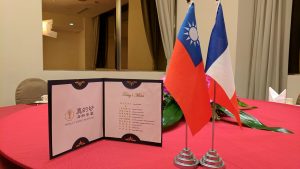2004 –
Inria Stars team and NCKU have been working together since 2004 on monitoring older adults using video understanding.
The consortium envisaged for this new project includes French teams that have also collaborated on joint projects for several years (ANR TecSan 2013 SafEE, FP7 Dem@care http://www.demcare.eu/), and French-Taiwanese teams (ANR TecSan 2009-2012 SweetHome, ANR TecSan 2013-2016 SafEE). National Taipei University of Technology has joined the consortium 3 years ago by providing new sensors.
2009 – 2012
In 2009 – 2012, we were part of the SWEET-HOME Project – monitoring Alzheimer’s disease patients at Nice Hospital, which was an ANR TECSAN French project on long-term monitoring of elderly people at Hospital with Nice City Hospital. The SWEET-HOME project built an innovative framework for modelling activities of daily living (ADLs) at home. These activities could help assessing elderly disease evolution (e.g. Alzheimer’s, depression, apathy) or detecting pre-cursors such as unbalanced walking, speed, walked distance, psychomotor slowness, frequent sighing and frowning, social withdrawal with a result of increasing indoor hours.
The SWEET-HOME project focused on two aspects related to Alzheimer’s disease: (1) to assess the initiative ability of patient and whether the patient is involved in goal directed behaviours (2) to assess walking disorders and potential risk of falls. In this focus, the goal was to collect and combine multi-sensor (audio-video) information to detect activities and assess behavioural trends to provide user services at different levels. In this project an experimental room was used in Nice-Cimiez Hospital for monitoring Alzheimer patients.
2013 – 2017
In 2013 – 2017, we were involved in the SafEE Project – Safe & Easy Environment for Alzheimer’s disease and related disorders, which was an ANR TECSAN French project on investigating technologies for stimulation and intervention for Alzheimer’s disease patients. French partners of the project included clinicians (CoBTeK, Nice Hospital and Nice University), computational research centers (INRIA) and industrials (Aromatherapeutics, SolarGames). Taiwan partners also included clinicians (Taichung Veterans General Hospital TVGH, NCKU Hospital), computational research laboratory (SMILE Lab at National Cheng Kung University NCKU) and industrials (BDE).
The SafEE project aimed at improving the safety, autonomy and quality of life of older people at risk or suffering from Alzheimer’s disease and related disorders. More specifically the SafEE project 1) focused on specific clinical targets in three domains: behavior, motricity and cognition; 2) merged assessment and non-pharmacological help/intervention and 3) proposed easy ICT device solutions for the end users. In this project, experimental studies have been conducted both in France (at Hospital and Nursery Home) and in Taiwan.
2018 – 2020
The activity for 2018 was to develop and adapt a software platform SUP that we can share with Taiwanese partners and secondly, that we can experiment with the medical partners.
SUP is a Scene Understanding Software Platform written in C++ designed for perceiving, analyzing and interpreting a 3D dynamic scene observed through one or two RGBD sensors. It encompasses algorithms allowing for the modeling of interesting activities for users to enable their recognition in real-world applications requiring high-throughput. SUP is able to recognize events such as ‘falling’, ‘walking’ of a person. SUP divides the work-flow of a video processing into several separated modules, such as acquisition, segmentation, up to activity recognition. Each module has a specific interface, and different plugins (corresponding to algorithms) can be implemented for a same module. We can easily build new analyzing systems thanks to this set of plugins. The order we can use those plugins and their parameters can be changed at run time and the result visualized on a dedicated GUI. This platform has many more advantages such as easy serialization to save and replay a scene, portability to Mac, Windows or Linux, and easy deployment to quickly setup an experimentation anywhere. SUP takes different kinds of input: RGB camera, depth sensor for online processing; or image/video files for offline processing.
The planned activity for 2019 consists in validating the technological system by integrating the most recent technologies such as Deep Learning and testing new types of sensors such as sleep sensor using hyper-spectral imaging. To realize this objective, we are planning the visits of senior researchers, as well as the exchange of young students (at master level). Other planned activity is to share non-pharmacological solutions developed in France to assess and manage affective symptoms in elderly people and present how clinical, biological, imaging and biosensors markers allow an earlier diagnostic of neurodegenerative diseases. To realize this objective, we are planning to export this solutions in Taiwan so that they can be tested in Taiwan’s hospitals.




